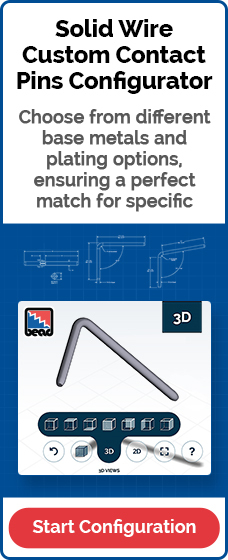At Bead Electronics, we are constantly evolving to answer the intricate questions of our clients and assist them in understanding the diverse applications and potential of hollow bead pins. Recently, we received a thoughtful query about the nature of these pins and how they could be secured within an assembly.
Today, let's dive deeper and explore the potential of hollow bead pins in different assemblies.

The Multifaceted Approaches to Securing Hollow Bead Pins
Securing a hollow pin isn't restricted to a one-size-fits-all solution. Its versatility allows for a gamut of securing methods that can be adapted to suit specific applications. From our extensive experience, we categorize these into five overarching approaches:
Press-fit: A popular method that can involve the use of additional pin features depending on the required tolerances. This method ensures a snug fit, leveraging the physical properties of the materials involved. For instance, when a client requires a connector, a press-fit could be suitable, particularly if the assembly involves plastic material.
Staked: Staking is a mechanical technique that is basically hitting the pin from one end. It is predominantly employed for metal or ceramic materials and is also effective for plastic. This versatile approach manifests in multiple forms: petal (commonly used in lamp bases), flatted (resembling a rivet), or control (which accommodates double-sided male pins). These diverse options cater to the distinct requirements of different industries, ensuring optimal functionality and precision.
Crimped: Crimped contacts are utilized to terminate multistrand wires for connection. This method can also be applied to various materials, ensuring a reliable and secure connection. The process involves pressing the wires into the contact, guaranteeing they remain intact during usage. Depending on the specific application, the contact or receptacle can take the form of a pin or socket.
Soldered: A less common approach for hollow pins, but can be used for larger diameter pins when the application is taking advantage of the low overall weight of a hollow pin.
Overmolded: Another infrequent approach for hollow pins occurs when the pin is encompassed within a molding material, ensuring stability and security.
Hollow pins can be used in many ways but ultimately your application will dictate which approach is most appropriate, which is where a skilled Applications Engineer can come in to advise you.
Delving Deeper: Addressing Specific Concerns
Presence of Seams: Hollow pins typically exhibit a seam that runs longitudinally along the part. This seam can sometimes play to our advantage in the manufacturing process. However, if a seamless structure is preferred, we can utilize seamless tubing to eliminate the seam, which might be necessitated for various reasons.
Compressibility & Rib Formation: The pins exhibit a degree of compressibility, contingent on the type of metal and the wall thickness. Sometimes, this inherent compressibility is sufficient to secure the pin.
In instances where additional securing force is required, we can introduce indents to create what may be referred to as a 'rib', which facilitates extra interference while mitigating insertion force. This is primarily because the full length of the part is not used for interference.
In one of our past projects, we successfully incorporated two indents added at different planes to a hollow pin. This alteration was not driven by the necessity of the press fit itself but was devised to augment our client's manufacturing process.
Harnessing Innovations to Support Customer Manufacturing Processes
At Bead Electronics, we are committed to leveraging the potential of hollow bead pins to meet a diverse range of industrial applications. Whether you're looking at press-fits or exploring the realms of soldering and over-molding, our expertise ensures we can tailor solutions to meet your precise requirements.
Our swaging technique allows us to produce hollow pins without generating any scrap, making our assemblies more environmentally friendly by reducing material usage by 30%. Compared to solid pins, Bead's hollow pin weighs only 63%, further enhancing its efficiency and sustainability.
For more insights and customized solutions, feel free to reach out to us. Together, we can shape the future of industrial assemblies, one hollow bead pin at a time.



